Abstract
Primary skin fibroblast cell lines from patients with Fanconi anemia were cotransfected with UV-irradiated pSV2neo plasmids and high molecular weight DNA from normal human cells. Restoration of a normal cellular resistance to mitomycin C (MMC) was observed provided that a Fanconi anemia cell line is selected for DNA-mediated transformation (neo gene) and that at least two successive rounds of transfection are performed. Cells were selected by taking advantage of the higher proliferation rate and plating efficiency of the MMC resistant transformants. As estimated from reconstruction experiments, the frequency of transfer of MMC resistance lies between 1 and 30 X 10(-7). The MMC resistance phenotype was maintained for at least 10 generations following transfection. Evidence for DNA-mediated transformation also includes the recovery of a normal pattern of DNA semiconservative synthesis after treatment with 8-methoxypsoralen and 365-nm UV irradiation, and the presence of exogenous pSV2neo DNA sequences was shown by Southern blot analysis. The acquired MMC resistance is probably due to the presence of DNA from normal cells. Indeed, sensitivity to MMC was maintained when Fanconi anemia cells were cotransfected with the UV-irradiated pSV2neo plasmid mixed with their own DNA or with yeast or salmon sperm DNA. These negative results also render unlikely the selection of spontaneous MMC resistant revertants in transfection of Fanconi anemia cells with normal DNA. These experiments establish the prerequisites for the isolation of the gene(s) involved in the response to DNA crosslinking lesions in human cells.
Full text
PDF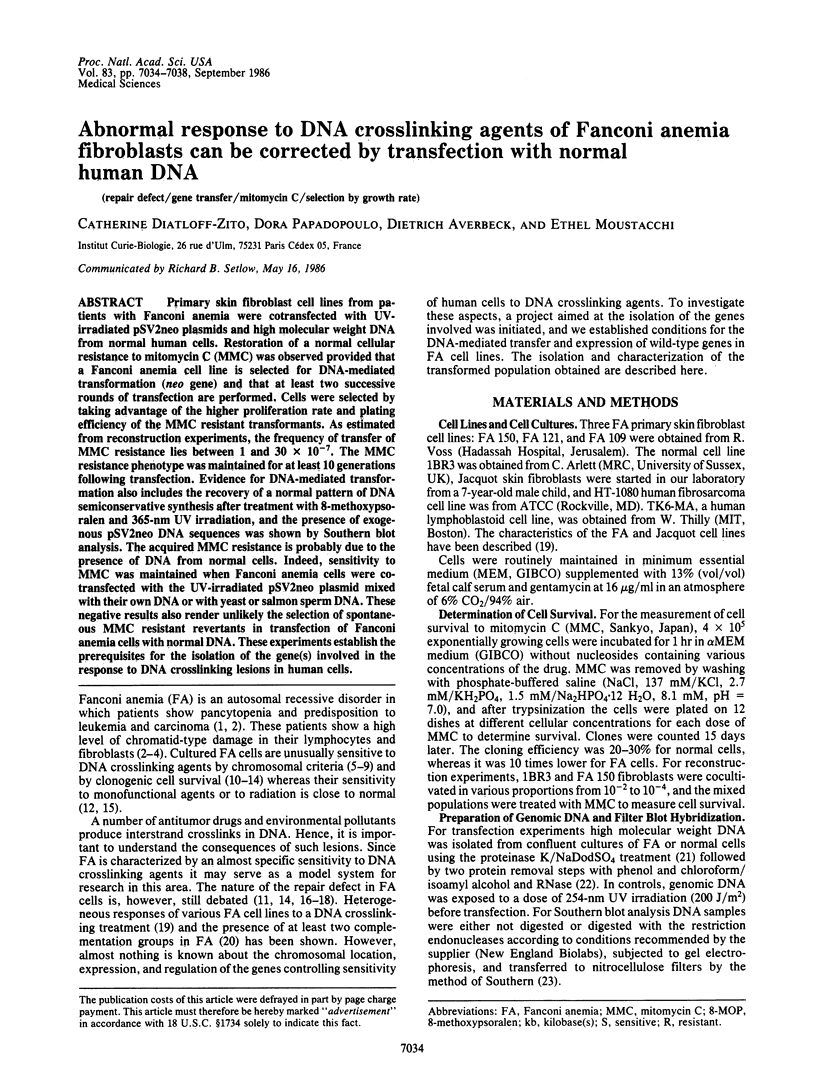
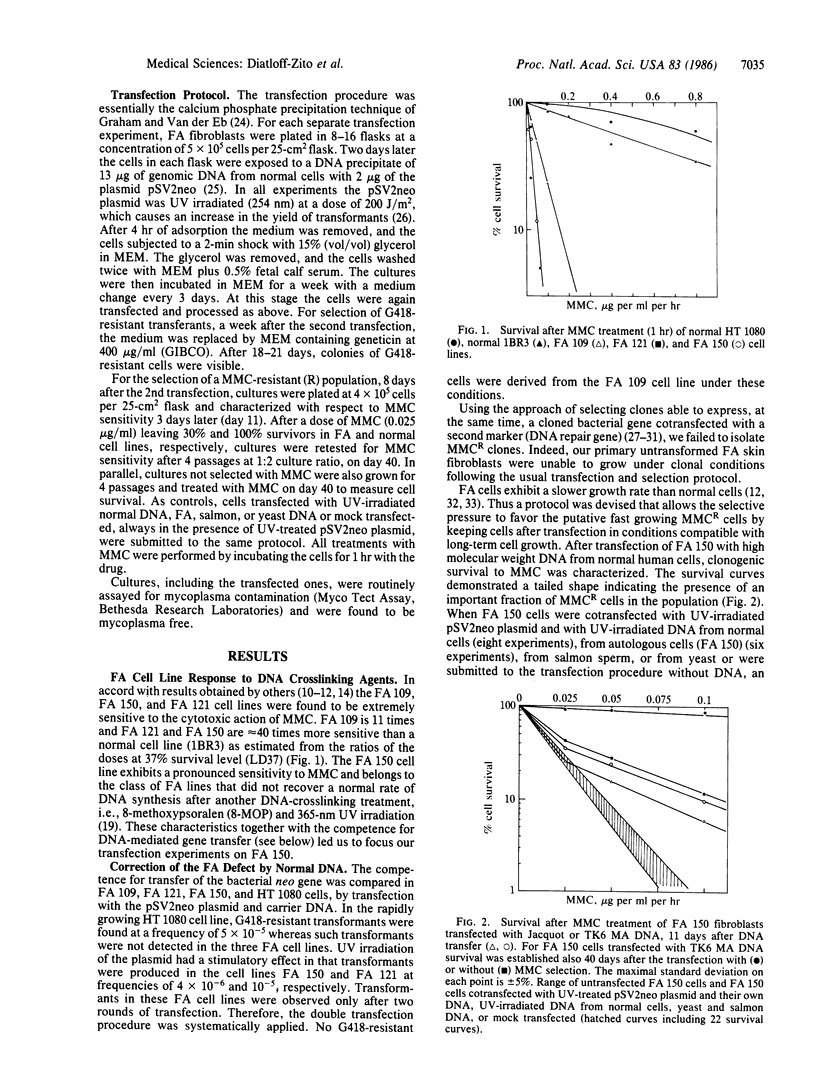
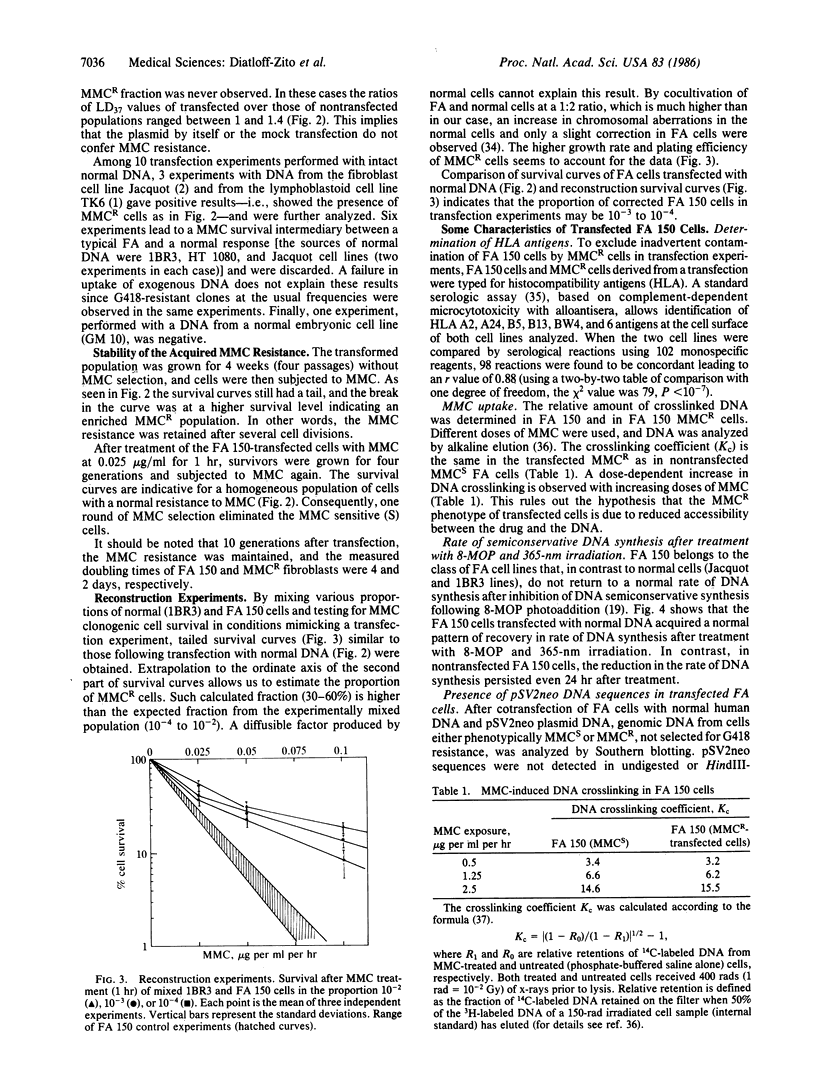
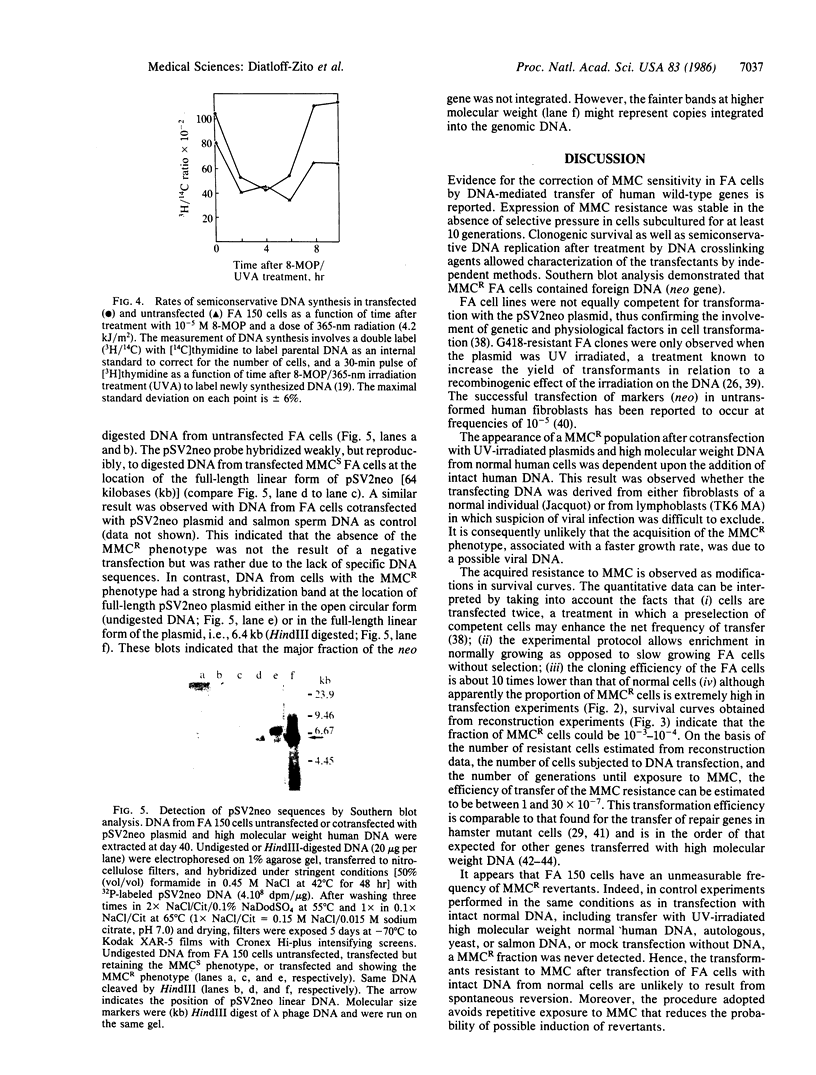
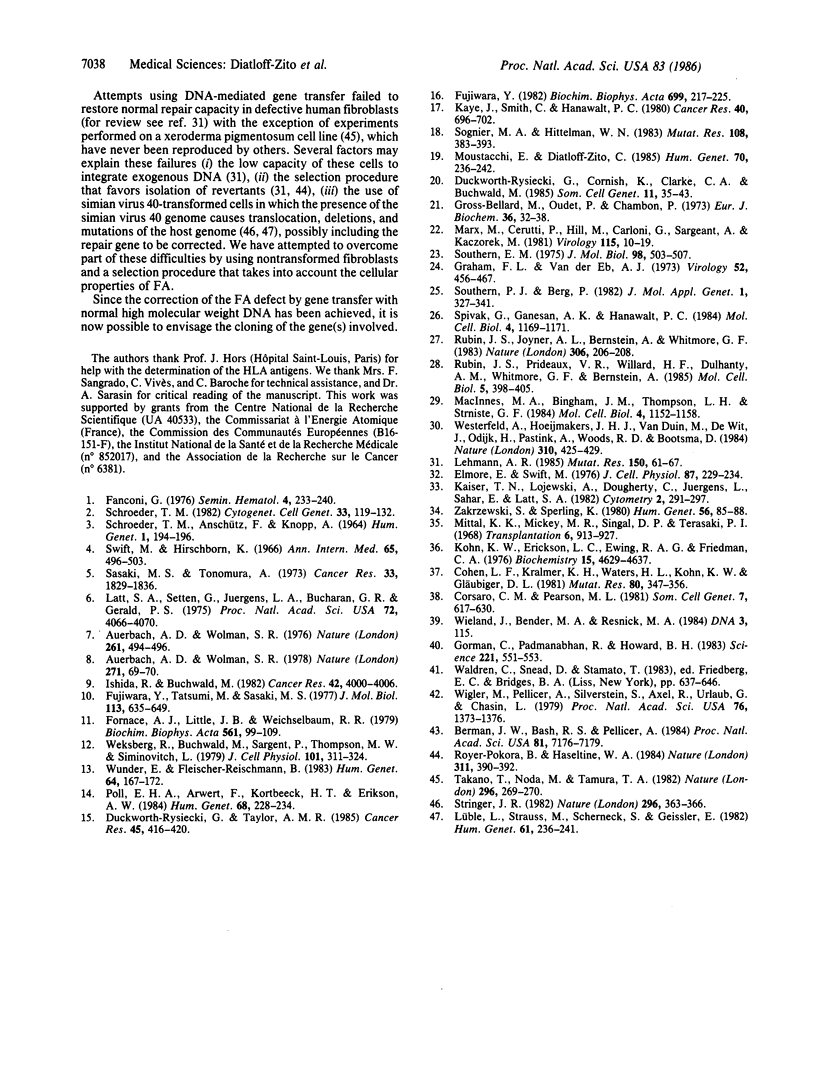
Images in this article
Selected References
These references are in PubMed. This may not be the complete list of references from this article.
- Auerbach A. D., Wolman S. R. Carcinogen-induced chromosome breakage in Fanconi's anaemia heterozygous cells. Nature. 1978 Jan 5;271(5640):69–71. doi: 10.1038/271069a0. [DOI] [PubMed] [Google Scholar]
- Auerbach A. D., Wolman S. R. Susceptibility of Fanconi's anaemia fibroblasts to chromosome damage by carcinogens. Nature. 1976 Jun 10;261(5560):494–496. doi: 10.1038/261494a0. [DOI] [PubMed] [Google Scholar]
- Berman J. W., Basch R. S., Pellicer A. Gene transfer in lymphoid cells: expression of the Thy-1.2 antigen by Thy-1.1 BW5147 lymphoma cells transfected with unfractionated cellular DNA. Proc Natl Acad Sci U S A. 1984 Nov;81(22):7176–7179. doi: 10.1073/pnas.81.22.7176. [DOI] [PMC free article] [PubMed] [Google Scholar]
- Cohen L. F., Kraemer K. H., Waters H. L., Kohn K. W., Glaubiger D. L. DNA crosslinking and cell survival in human lymphoid cells treated with 8-methoxypsoralen and long wavelength ultraviolet radiation. Mutat Res. 1981 Feb;80(2):347–356. doi: 10.1016/0027-5107(81)90107-x. [DOI] [PubMed] [Google Scholar]
- Corsaro C. M., Pearson M. L. Competence for DNA transfer of ouabain resistance and thymidine kinase: clonal variation in mouse L-cell recipients. Somatic Cell Genet. 1981 Sep;7(5):617–630. doi: 10.1007/BF01549663. [DOI] [PubMed] [Google Scholar]
- Duckworth-Rysiecki G., Cornish K., Clarke C. A., Buchwald M. Identification of two complementation groups in Fanconi anemia. Somat Cell Mol Genet. 1985 Jan;11(1):35–41. doi: 10.1007/BF01534732. [DOI] [PubMed] [Google Scholar]
- Duckworth-Rysiecki G., Taylor A. M. Effects of ionizing radiation on cells from Fanconi's anemia patients. Cancer Res. 1985 Jan;45(1):416–420. [PubMed] [Google Scholar]
- Elmore E., Swift M. Growth of cultured cells from patients with Fanconi anemia. J Cell Physiol. 1975 Dec;87(2):229–233. doi: 10.1002/jcp.1040870211. [DOI] [PubMed] [Google Scholar]
- Fanconi G. Familial constitutional panmyelocytopathy, Fanconi's anemia (F.A.). I. Clinical aspects. Semin Hematol. 1967 Jul;4(3):233–240. [PubMed] [Google Scholar]
- Fornace A. J., Jr, Little J. B., Weichselbaum R. R. DNA repair in a Fanconi's anemia fibroblast cell strain. Biochim Biophys Acta. 1979 Jan 26;561(1):99–109. doi: 10.1016/0005-2787(79)90494-5. [DOI] [PubMed] [Google Scholar]
- Fujiwara Y. Defective repair of mitomycin C crosslinks in Fanconi's anemia and loss in confluent normal human and xeroderma pigmentosum cells. Biochim Biophys Acta. 1982 Dec 31;699(3):217–225. doi: 10.1016/0167-4781(82)90110-5. [DOI] [PubMed] [Google Scholar]
- Fujiwara Y., Tatsumi M. Cross-link repair in human cells and its possible defect in Fanconi's anemia cells. J Mol Biol. 1977 Jul 15;113(4):635–649. doi: 10.1016/0022-2836(77)90227-3. [DOI] [PubMed] [Google Scholar]
- Gorman C., Padmanabhan R., Howard B. H. High efficiency DNA-mediated transformation of primate cells. Science. 1983 Aug 5;221(4610):551–553. doi: 10.1126/science.6306768. [DOI] [PubMed] [Google Scholar]
- Graham F. L., van der Eb A. J. A new technique for the assay of infectivity of human adenovirus 5 DNA. Virology. 1973 Apr;52(2):456–467. doi: 10.1016/0042-6822(73)90341-3. [DOI] [PubMed] [Google Scholar]
- Gross-Bellard M., Oudet P., Chambon P. Isolation of high-molecular-weight DNA from mammalian cells. Eur J Biochem. 1973 Jul 2;36(1):32–38. doi: 10.1111/j.1432-1033.1973.tb02881.x. [DOI] [PubMed] [Google Scholar]
- Ishida R., Buchwald M. Susceptibility of Fanconi's anemia lymphoblasts to DNA-cross-linking and alkylating agents. Cancer Res. 1982 Oct;42(10):4000–4006. [PubMed] [Google Scholar]
- Kaiser T. N., Lojewski A., Dougherty C., Juergens L., Sahar E., Latt S. A. Flow cytometric characterization of the response of Fanconi's anemia cells to mitomycin C treatment. Cytometry. 1982 Mar;2(5):291–297. doi: 10.1002/cyto.990020505. [DOI] [PubMed] [Google Scholar]
- Kaye J., Smith C. A., Hanawalt P. C. DNA repair in human cells containing photoadducts of 8-methoxypsoralen or angelicin. Cancer Res. 1980 Mar;40(3):696–702. [PubMed] [Google Scholar]
- Kohn K. W., Erickson L. C., Ewig R. A., Friedman C. A. Fractionation of DNA from mammalian cells by alkaline elution. Biochemistry. 1976 Oct 19;15(21):4629–4637. doi: 10.1021/bi00666a013. [DOI] [PubMed] [Google Scholar]
- Latt S. A., Stetten G., Juergens L. A., Buchanan G. R., Gerald P. S. Induction by alkylating agents of sister chromatid exchanges and chromatid breaks in Fanconi's anemia. Proc Natl Acad Sci U S A. 1975 Oct;72(10):4066–4070. doi: 10.1073/pnas.72.10.4066. [DOI] [PMC free article] [PubMed] [Google Scholar]
- Lehmann A. R. Use of recombinant DNA techniques in cloning DNA repair genes and in the study of mutagenesis in mammalian cells. Mutat Res. 1985 Jun-Jul;150(1-2):61–67. doi: 10.1016/0027-5107(85)90101-0. [DOI] [PubMed] [Google Scholar]
- Lübbe L., Strauss M., Scherneck S., Geissler E. The DNA tumor virus SV 40 induces gene mutations in human cells. Reversion of HPRT deficiency. Hum Genet. 1982;61(3):236–241. doi: 10.1007/BF00296449. [DOI] [PubMed] [Google Scholar]
- MacInnes M. A., Bingham J. M., Thompson L. H., Strniste G. F. DNA-mediated cotransfer of excision repair capacity and drug resistance into chinese hamster ovary mutant cell line UV-135. Mol Cell Biol. 1984 Jun;4(6):1152–1158. doi: 10.1128/mcb.4.6.1152. [DOI] [PMC free article] [PubMed] [Google Scholar]
- Marx M., Cerutti P., Hill M., Carloni G., Sergeant A., Kaczorek M. Continuous production of Rous sarcoma virus free of transformation defective virus in clones of established RSV-transformed quail cells. Virology. 1981 Nov;115(1):10–19. doi: 10.1016/0042-6822(81)90084-2. [DOI] [PubMed] [Google Scholar]
- Mittal K. K., Mickey M. R., Singal D. P., Terasaki P. I. Serotyping for homotransplantation. 18. Refinement of microdroplet lymphocyte cytotoxicity test. Transplantation. 1968 Nov;6(8):913–927. doi: 10.1097/00007890-196811000-00006. [DOI] [PubMed] [Google Scholar]
- Moustacchi E., Diatloff-Zito C. DNA semi-conservative synthesis in normal and Fanconi anemia fibroblasts following treatment with 8-methoxypsoralen and near ultraviolet light or with X-rays. Hum Genet. 1985;70(3):236–242. doi: 10.1007/BF00273448. [DOI] [PubMed] [Google Scholar]
- Poll E. H., Arwert F., Kortbeek H. T., Eriksson A. W. Fanconi anaemia cells are not uniformly deficient in unhooking of DNA interstrand crosslinks, induced by mitomycin C or 8-methoxypsoralen plus UVA. Hum Genet. 1984;68(3):228–234. doi: 10.1007/BF00418393. [DOI] [PubMed] [Google Scholar]
- Royer-Pokora B., Haseltine W. A. Isolation of UV-resistant revertants from a xeroderma pigmentosum complementation group A cell line. 1984 Sep 27-Oct 3Nature. 311(5984):390–392. doi: 10.1038/311390a0. [DOI] [PubMed] [Google Scholar]
- Rubin J. S., Joyner A. L., Bernstein A., Whitmore G. F. Molecular identification of a human DNA repair gene following DNA-mediated gene transfer. Nature. 1983 Nov 10;306(5939):206–208. doi: 10.1038/306206a0. [DOI] [PubMed] [Google Scholar]
- Rubin J. S., Prideaux V. R., Willard H. F., Dulhanty A. M., Whitmore G. F., Bernstein A. Molecular cloning and chromosomal localization of DNA sequences associated with a human DNA repair gene. Mol Cell Biol. 1985 Feb;5(2):398–405. doi: 10.1128/mcb.5.2.398. [DOI] [PMC free article] [PubMed] [Google Scholar]
- Sasaki M. S., Tonomura A. A high susceptibility of Fanconi's anemia to chromosome breakage by DNA cross-linking agents. Cancer Res. 1973 Aug;33(8):1829–1836. [PubMed] [Google Scholar]
- Schroeder T. M., Anschütz F., Knopp A. Spontane Chromosomenaberrationen bei familiärer Panmyelopathie. Humangenetik. 1964;1(2):194–196. doi: 10.1007/BF00389636. [DOI] [PubMed] [Google Scholar]
- Schroeder T. M. Genetically determined chromosome instability syndromes. Cytogenet Cell Genet. 1982;33(1-2):119–132. doi: 10.1159/000131736. [DOI] [PubMed] [Google Scholar]
- Sognier M. A., Hittelman W. N. Loss of repairability of DNA interstrand crosslinks in Fanconi's anemia cells with culture age. Mutat Res. 1983 Mar;108(1-3):383–393. doi: 10.1016/0027-5107(83)90134-3. [DOI] [PubMed] [Google Scholar]
- Southern E. M. Detection of specific sequences among DNA fragments separated by gel electrophoresis. J Mol Biol. 1975 Nov 5;98(3):503–517. doi: 10.1016/s0022-2836(75)80083-0. [DOI] [PubMed] [Google Scholar]
- Southern P. J., Berg P. Transformation of mammalian cells to antibiotic resistance with a bacterial gene under control of the SV40 early region promoter. J Mol Appl Genet. 1982;1(4):327–341. [PubMed] [Google Scholar]
- Spivak G., Ganesan A. K., Hanawalt P. C. Enhanced transformation of human cells by UV-irradiated pSV2 plasmids. Mol Cell Biol. 1984 Jun;4(6):1169–1171. doi: 10.1128/mcb.4.6.1169. [DOI] [PMC free article] [PubMed] [Google Scholar]
- Stringer J. R. DNA sequence homology and chromosomal deletion at a site of SV40 DNA integration. Nature. 1982 Mar 25;296(5855):363–366. doi: 10.1038/296363a0. [DOI] [PubMed] [Google Scholar]
- Swift M. R., Hirschhorn K. Fanconi's anemia. Inherited susceptibility to chromosome breakage in various tissues. Ann Intern Med. 1966 Sep;65(3):496–503. doi: 10.7326/0003-4819-65-3-496. [DOI] [PubMed] [Google Scholar]
- Takano T., Noda M., Tamura T. Transfection of cells from a xeroderma pigmentosum patient with normal human DNA confers UV resistance. Nature. 1982 Mar 18;296(5854):269–270. doi: 10.1038/296269a0. [DOI] [PubMed] [Google Scholar]
- Weksberg R., Buchwald M., Sargent P., Thompson M. W., Siminovitch L. Specific cellular defects in patients with Fanconi anemia. J Cell Physiol. 1979 Nov;101(2):311–323. doi: 10.1002/jcp.1041010211. [DOI] [PubMed] [Google Scholar]
- Westerveld A., Hoeijmakers J. H., van Duin M., de Wit J., Odijk H., Pastink A., Wood R. D., Bootsma D. Molecular cloning of a human DNA repair gene. Nature. 1984 Aug 2;310(5976):425–429. doi: 10.1038/310425a0. [DOI] [PubMed] [Google Scholar]
- Wigler M., Pellicer A., Silverstein S., Axel R., Urlaub G., Chasin L. DNA-mediated transfer of the adenine phosphoribosyltransferase locus into mammalian cells. Proc Natl Acad Sci U S A. 1979 Mar;76(3):1373–1376. doi: 10.1073/pnas.76.3.1373. [DOI] [PMC free article] [PubMed] [Google Scholar]
- Wunder E., Fleischer-Reischmann B. Response of lymphocytes from Fanconi's anemia patients and their heterozygous relatives to 8-methoxy-psoralene in a cloning survival test system. Hum Genet. 1983;64(2):167–172. doi: 10.1007/BF00327118. [DOI] [PubMed] [Google Scholar]
- Zakrzewski S., Sperling K. Antagonistic effect of cocultivation on mitomycin C-induced aberration rate in cells of a patient with Fanconi's anemia and in Chinese hamster ovary cells. Hum Genet. 1980;56(1):85–88. doi: 10.1007/BF00281574. [DOI] [PubMed] [Google Scholar]



